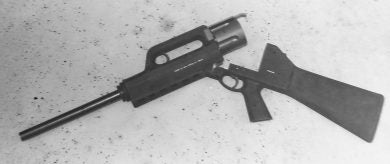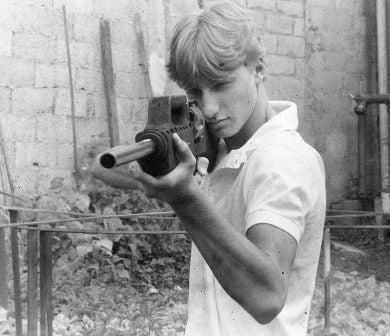Today’s post on the work of Brazilian gun designer Nelmo Suzano (1930-2013) brings to light a somewhat unique 12-ga shotgun you TFB readers may have never heard about, the Pentagun.
In the mid 1980s, Nelmo Suzano had one more prototype gun materialized during his venture in the short-lived ENARM – Empresa Nacional de Armas company. By using the workshops of the Haga metallurgical factory in Nova Friburgo, Rio de Janeiro State, he came up with a weapon that entirely departed from his traditional submachine gun line: a 12-gauge shotgun. Properly called the Pentagun, design and prototype construction work took him about ten months to complete in 1986, the whole thing being ready by December of that year. It was expected to undergo and complete Brazilian Army certification tests sometime during 1987 and be ready for series production in about one more year.

The 510mm-barrel Pentagun is seen here fitted with a muzzle brake. The all-polymer pistol grip and handguard/carry handle unit look like those of the earlier LAPA 5.56x45mm bullpup rifle.
The Pentagun was a five-round shotgun with a revolver-type cylinder which fired double-action only. With a pretty unusual look, it employed polymer components extensively in its construction. It was intended to be, basically, a 12-gauge weapon, but by simply changing (no tools required) the barrel and cylinder, 20- and 28-gauge ammo could be used. To open the gun, a retaining latch was pulled back, which allowed the barrel to drop and exposed the rear of the cylinder for loading. The gun was closed for action by lifting the barrel, thus locking the latch automatically.

The weapon in the broken barrel position to allow ammo loading into the prominent 5-round cylinder.

A close-up view of the gun’s cylinder area. The cartridge extractor, in the center, was actuated by the curved lever within the carry handle.

A 12-gauge cartridge being loaded into the cylinder, above which is the part that locked into the rear latch to keep the gun firmly closed.
When the trigger was pulled, the cylinder was unlocked from position and the hammer began to move rearwards. At this stage, for night or poor-light use, a LED (Light Emitting Diode) was automatically activated inside the tubular sight within the carry handle by means of a micro-switch attached to the trigger mechanism. An on/off switch was located in the lower part of the handguard. The cylinder was given an initial anti-clockwise revolving motion, and the hammer continued its rearward motion. As the cylinder moved one-fifth of a revolution, it was locked in place with one chamber aligned with the barrel breech. At this last stage of the trigger movement (about 2mm from the let-off point), a rod attached to it and which ran in the interior of the handguard, pulled the barrel about 1.5mm backwards, thus forcing the rear end into the mouth of the aligned chamber to make a gas seal. This rod had a roller-link chain section at its center which allowed the shotgun to be broken open for loading. As the trigger reached its full travel backwards, the hammer was released and fired the cartridge in the chamber. The operator then released the trigger, which allowed the barrel and hammer to return to their rest positions, and the firing cycle could then be started once more. To reload, the weapon was broken open and cartridge extraction was achieved by pulling back a handle located within the carry handle.
Description of the whole operation process takes much longer than actually using the Pentagun, which was, in fact, an uncomplicated affair. The sole prototype completed was in the 12-ga caliber and worked adequately to justify being submitted to certification tests, which never occurred. As it happened with most of Nelmo Suzano’s guns, it featured a straight-line configuration, thus resulting in minimum muzzle raise when firing. However, internal disagreements within the ENARM company partners led to its dissolution in a short term. A pity, one more time.
Pentagun basic specifications: empty weight, 3.1kg; barrel length, 510mm (commercial)/290mm (military/police; overall length, 900mm (commercial)/680mm (military/police).

A short 290mm barrel, seen here with a muzzle brake, was proposed for use in a military/LE version. Hmmm, a smart-looking gun, in author’s opinion.

Author’s son Alexander, 18 at the time, was one of the many Pentagun fans who grieved for the weapon’s premature death.
 Your Privacy Choices
Your Privacy Choices
